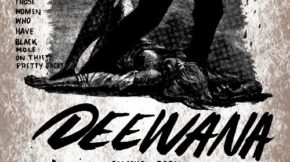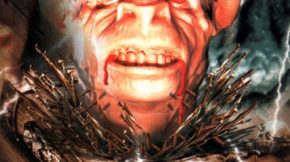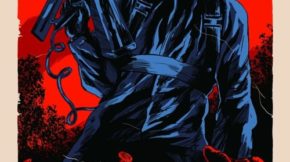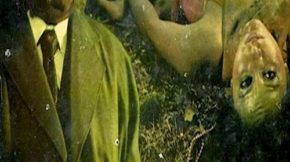Hawa (2003)
Hawa (2003)
Cast: Tabu, Shahbaz Khan, Imran Khan, Suresh Chatwal, Baby Hansika
Director: Guddu Dhanoa
Nutshell: Single, independent mother and kids are assailed by dreadful Evil Wind!
Some good news and some bad news: the good news first. With the arrival of Hawa and Saaya following soon after the successful Bhoot, it seems that not a month goes by in Bollywood these days without some pseudo horror film hitting cinemas, making a welcome change from the diet of “Archies” style MTV piffle that is so prevalent these days.
The other good news is that arguably Lollywood’s finest current actress is cast in the central role of Sanjana and thirdly that the running time is (just) two hours and lastly that there are no songs at all. So expectations were fairly high for this supposedly serious and dark horror film featuring a self-touted theme of “sexual violence and supernatural terror”. Knowing audiences spot the early “homage” to The Shining as there are aerial shots of a car winding its way up to some lonely looking snow speckled roads with the very same music being employed that opened Kubrik’s horror epic. A woman whose marriage has fallen apart is moving to a remote town near the Tibetan border with her two young daughters and her own adopted gay brother (he has shirtless Hritik Roshan posters adorning his walls!).
There is considerable panic along the way when the car gets stuck on a precarious bridge, and an eerie wind kicks up as the vehicle finally winds its way to the new residence. Then the next day, even more mysteriously, she spots an old Tibetan hag staring at her, who then hobbles over to her antique shop and hands her a trinket telling her to keep it as it is of great importance. Taken aback and not understanding the relevance of the hag’s words, Sanjana sells the amulet off to some tourists with very odd accents who fall in love with the object even before looking at it.
The kids are delighted upon arriving at a spacious house, and Sanjana is also satisfied that they seem happy in their new surroundings. However, it’s not long before weird things start happening. The first morning after their arrival, Sanjana is woken up by the religious chanting of a congregation of locals outside attempting to “exorcise” a spot that had been struck by lightning during the storm of the previous night. Then a night or so later, Tramp, the family German shepherd, goes bounding off only to be discovered much later by its owner Sanjana’s brother. The relief on the brothers’ face is soon turned to horror as the dog suddenly turns on him with vicious intent – remember the dog in Signs? A few nights later, the dog’s condition appears to have deteriorated as when Sanjana approaches him, he explodes into a rage and leaps through the air like a catapult aiming straight for her throat. Fortunately, being a spirited modern Indian lass who works out regularly, she can dodge the dreadful beast. Instead, the poor mutt lands on a shard of glass with a suitably deflating effect.
The kids are initially a little peeved at the loss of their beloved Tramp, but life goes on. Later in the same spot where poor Tramp was impaled, a bewildering cluster of Blair Witch stone formations appear for no apparent reason at all. Still, Sanjana is suitably spooked, no doubt having recently watched The Blair Witch Project. Sanjana’s car, a problem at the best of times, now takes to flying around the Tibetan countryside at breakneck speed, without a driver! It soon becomes evident that there is a disgruntled spirit in the house because doors open by themselves and beds start to rumble like they did in The Exorcist, and tables and furniture start flying around on their own free will.
Then finally, poor Sanjana is attacked and brutally raped by an unseen force that she claims you can feel, but you can’t see – a long and very uncomfortable scene gratuitously shot by the director who displays a frightening grasp of smut. A National Award-winning actress is made to wiggle around and simulate being raped for ten minutes while the camera lurches back and forth in a not so subtle enactment of a brutal rape. It’s a pretty stomach-turning scene and uncomfortably exploitative, and one wonders how Tabu got into a film as sleazy as this one promised to be. A few minutes further on, she is again brutally assaulted by the sex-mad “demon wind” and humped viciously from behind with her face pressed against the wall – another gratuitous interlude that is remarkably sleazy and difficult to watch. Ten minutes further down the movie, we are treated to a third brutal rape by the unseen wind though the last such scene, the wind takes a gentle approach. The audience is shown that Sanjana is thoroughly enjoying sex with the wind this time around, leading her to climax which triggers a wave of embarrassment and disgust at herself for enjoying the touch of an evil spirit.
There are some hysterical scenes when the passionate spirit, unable to exert the slightest control over its burgeoning sexual appetite, takes to disrobing Sanjana in broad daylight in the middle of the street, tugging mischievously at her sari and pawing her blouse! A natty psychiatrist is hauled into the mix to try to find the root of Sanjana’s traumas, but all the creep seems to do is ask her about her sexual cravings and how she must desire physical relations now and then. A real fraudster of a shrink who is hoping to be the next man in Sanjana’s life, but when things start getting out of hand, they have to resort to a trusty Tantrik, even if he is of a new age, a suit-wearing variety who doesn’t carry a pitchfork around. But, that doesn’t mean his methods and his manner isn’t any less ridiculous than those beautiful and typically robust saffron-robed Tantriks whom one has grown to love and admire so much over the years.
This Tantrik is no less a ridiculous sight spouting his gibberish and mumbo jumbo in English of a change. The director thought that making his Tantrik wear a suit and tie and spout his gibberish in English would lend authenticity and realism to modern times. The ploy doesn’t work. Nothing in this movie works as it is based on a total confusion of ideas, borrowing snatches from genre films here and there and creating a bizarre potpourri of nonsensical garbage that is often as offensive as it is outright dumb. The story doesn’t even begin to hold up, and there is no semblance of any logic to the events on screen. The mysterious Tibetan Lady is never explained, nor is the dogs mysterious behaviour, and there is no common thread that links events together to give the film some overall shape.
Right at the end, a hugely lame “reason” is given for why poor Sanjana became the target of the demonic wind – simply because the house she moved into was struck by lightning somewhere in the yard outside. For this reason, she was repeatedly raped and eventually, her child is dragged into a netherworld by a goblin-like CGI demon.
What a total chaotic mess this film is from beginning to end. It’s best not to bother to make sense of this piece of nonsense but more interesting to spot the “homage” to genre hits from the west. The Evil Dead remains the film that has most influenced Hawa, but elements are also taken from Blair Witch, Signs, Evil Dead 2 and even your stock Dracula film.
One wonders why an actor of the calibre of Tabu felt the need to appear in z-grade garbage like this. Surely her career hasn’t yet plummeted to that extent that she has to sign up for films that even Mohan Bhakri would have turned his nose up at. The film is a dismal throwback to the mid 80’s special effects-driven horror flicks like the house, but this one suffers from having a very nasty sexual edge, and the special effects are anything but special. Hawa is a bagful of very harsh and foul hot wind!
Summary
Single, independent mother and kids are assailed by dreadful Evil Wind!












